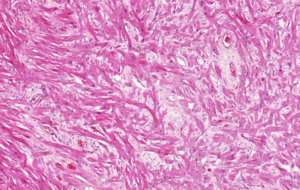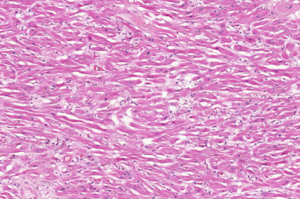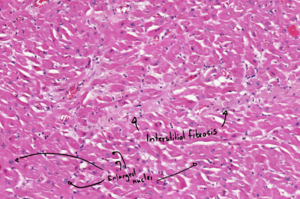40. Hypertrophic cardiomyopathy: Difference between revisions
(Created page with "'''Staining''': HE '''Organ''': Myocardium '''Description''': We can see the normal signs of hypertrophic myocardium: interstitial fibrosis, enlarged nuclei and (some) lipofuscin pigment. In an area almost in the exact middle of the slide is an area where the myocardial cells have lost their orientation. '''Diagnosis''': Hypertrophic cardiomyopathy '''Causes''': * Genetic defects '''Theory''': Hypertrophic cardiomyopathy has the same microscopic morphology as si...") |
No edit summary |
||
| Line 1: | Line 1: | ||
'''Staining''': HE | [[File:Hypertrophic cardiomyopathy overview.png|thumb|The marked area is where you’ll find the evidence for hypertrophic cardiomyopathy. Note how it’s between the artery on the upper left and the big vein (?) on the lower right. That should make it easier to find. If you have trouble recognizing the slide you can remember the blocky appearance of the upper right corner of the slide.]]'''Staining''': HE | ||
'''Organ''': Myocardium | '''Organ''': Myocardium | ||
| Line 18: | Line 18: | ||
Hypertrophic cardiomyopathy has the same microscopic morphology as simple hypertrophic myocardium, but also has areas where there is ''loss of orientation''. | Hypertrophic cardiomyopathy has the same microscopic morphology as simple hypertrophic myocardium, but also has areas where there is ''loss of orientation''. | ||
[[File:Hypertrophic cardiomyopathy close-up.png|thumb|Close-up of that area. Note how the myocardial fibres have no direction. Compare with the picture below|left]] | |||
[[File:Hypertrophic cardiomyopathy close-up.png | [[File:Hypertrophic cardiomyopathy longitudinal.png|thumb|From the same slide, but from another area of the slide where the loss of orientation can’t be seen, only the normal signs of hypertrophic myocardium|left]] | ||
[[File:Hypertrophic cardiomyopathy longitudinal.png | [[File:Hypertrophic cardiomyopathy perpendicular.png|thumb|Normal signs of hypertrophic myocardium]] | ||
[[File:Hypertrophic cardiomyopathy perpendicular.png | |||
[[Category:Pathology 1 - Histopathology slides]] | [[Category:Pathology 1 - Histopathology slides]] | ||
Revision as of 12:24, 5 July 2024

Staining: HE
Organ: Myocardium
Description:
We can see the normal signs of hypertrophic myocardium: interstitial fibrosis, enlarged nuclei and (some) lipofuscin pigment.
In an area almost in the exact middle of the slide is an area where the myocardial cells have lost their orientation.
Diagnosis: Hypertrophic cardiomyopathy
Causes:
- Genetic defects
Theory:
Hypertrophic cardiomyopathy has the same microscopic morphology as simple hypertrophic myocardium, but also has areas where there is loss of orientation.



